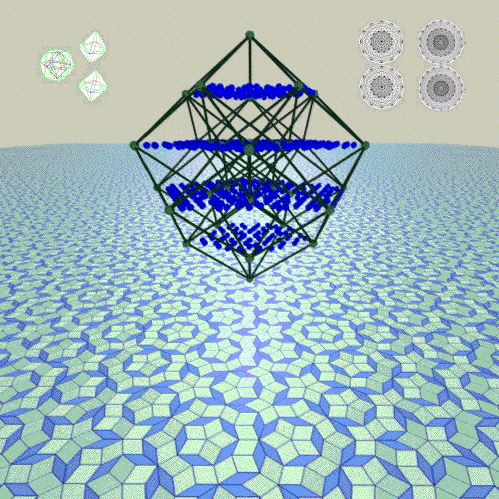Introduction to my May
2002 Cookeville Clifford Algebra talk:
Complex Clifford
Periodicity
Cl(2N;C) = Cl(2;C) x ...(N times tensor
product)... x Cl(2;C)
Cl(2;C) = M2(C) = 2x2 complex matrices
spinor representation = 1x2 complex column
spinors
Hyperfinite II1 von
Neumann Algebra factor is the completion
of the union of all the tensor products
Cl(2;C) x ...(N times tensor product)... x
Cl(2;C)
By looking at the spinor representation, you see
that "the hyperfinite II1 factor is the smallest von Neumann algebra
containing the creation and annihilation operators on a fermionic
Fock space of countably infinite dimension."
In other words, Complex Clifford Periodicity leads
to the complex hyperfinite II1 factor which represents Dirac's
electron-positron fermionic Fock space.
Now, generalize this to get a
representation of ALL the particles and fields of
physics.
Use Real
Clifford Periodicity to construct a
Real Hyperfinite
II1 factor as the completion of the union
of all the tensor products
Cl(1,7;R) x ...(N times tensor product)... x
Cl(1,7;R)
where the Real Clifford Periodicity is
Cl(N,7N;R) = Cl(1,7;R) x ...(N times tensor
product)... x Cl(1,7;R)
The components of the Real Hyperfinite II1 factor
are each
Cl(1,7;R)
[ my convention is (1,7) = (-+++++++) ]
Cl(1,7) is 2^8 = 16x16 =
256-dimensional, and has graded structure
1 8 28 56 70 56 28 8 1
What are the
physical interpretations of its
representations?
There are two mirror image half-spinors, each of
the form of a real (1,7) column vector with octonionic
structure.
The 1 represents:
The 7 represent:
- the electron;
- the red, blue, and green up
quarks;
- the red, blue, and green down
quarks.
One half-spinor represents first-geneneration
fermion particles, and its mirror image represents first-generation
fermion antiparticles.
Second and third generation fermions come from
dimensional reduction of spacetime, so that
- first generation - octonions
- second generation - pairs of octonions
- third generation - triples of
octonions
There is a (1,7)-dimensional vector
representation that corresponds to an 8-dimensional high-energy
spacetime with octonionic structure
that reduces at lower energies to quaternionic
structures that are
- a (1,3)-dimensional physical spacetime
[my convention is (1,3)=(-+++)]
- a (0,4)-dimensional internal symmetry
space
There is a 28-dimensonal bivector representation
that corresponds to the gauge symmetry Lie algebra
Spin(1,7)
that reduces at lower energies
to:
- a 16-dimensional U(2,2) = U(1)xSU(2,2) =
U(1)xSpin(2,4) whose conformal Lie algebra / Lie group structure
leads to gravity by a mechanism similar to the MacDowell-Mansouri
mechanism;
- a 12-dimensional SU(3)xSU(2)xU(1) Standard
Model symmetry group that is represented on the internal symmetry
space by the structure SU(3) / SU(2)xU(1) = CP2.
There is a 1-dimensional scalar representation for
the Higgs
mechanism.
The above structures fit together to form a
Lagrangian

that reduces to a Lagrangian for Gravity plus the
Standard Model.
Representations have geometric structure related
to E6

E6 is an exceptional simple graded Lie algebra of
the second kind:
E6 = g =
g-2 + g-1 + g0 + g1 + g2
g0 = so(1,7) + R + iR
dim g-1 = 16
dim g-2 = 8
This gives real Shilov
boundary geometry of S1xS7 for
(1,7)-dimensional high-energy spacetime representation and for the
first generation half-spinor fermion representations.
The geometry of the representation spaces, along
with combinatorial structure of second and third generation fermions,
allows calculation of relative force strengths and particle
masses:
- electromagnetic fine structure constant =
1/137.03608
- weak force - Higgs VEV = 252.5 GeV
- Higgs mass = 145.8 GeV
- Gfermi = (Gweak)(Mproton)^2 = 1.02 x
10^(-5)
- W+ mass = W- mass = 80.326 GeV
- Z0 mass = 91.862 GeV
- color force strength = 0.6286 (at 0.245 GeV) -
perturbative QCD running gives
- color force strength = 0.167 (at 5.3
GeV)
- color force strength = 0.121 (at 34
GeV)
- color force strength = 0.106 (at 91
GeV)
- If Nonperturbative QCD and other things are
taken into account, then the color force strength = 0.123 (at
91 GeV)
- Gravitational G = (Ggravity)(Mproton)^2 = 5 x
10^(-39)
- Me = 0.5110 MeV (assumed, since it is mass
ratios that are calculated)
- Me-neutrino = Mmu-neutrino = Mtau-neutrino = 0
(tree-level)
- Md = Mu = 312.8 MeV (constituent quark
mass)
- Mmu = 104.8 MeV
- Ms = 625 MeV (constituent quark
mass)
- Mc = 2.09 GeV (constituent quark
mass)
- Mtau = 1.88 GeV
- Mb = 5.63 GeV (constituent quark
mass)
- Mt = 130
GeV
(constituent
Truth Quark mass)
However:
Fermilab says that the T-quark mass is about
170 GeV.
?? Which is the True
T-quark mass: 130 or 170 ??
The quote is from John Baez's web page week 175 at
http://math.ucr.edu/home/baez/week175.html
E6 GLA structure is from Soji Kaneyuki's writing in Analysis and
Geometry on Complex Homogeneous Domains, by Jacques Faraut, Soji
Kaneyuki, Adam Koranyi, Qi-keng Lu, and Guy Roos (Birkhauser 2000).
Frank D. (Tony) Smith, Jr., Cartersville,
GA, March 2002http://www.innerx.net/personal/tsmith/TShome.html

